GIGABYTE Z97X-SOC Force Review
by Ian Cutress on June 17, 2014 1:00 PM EST- Posted in
- Motherboards
- Gigabyte
- Overclocking
- Z97
Real World CPU Benchmarks
Readers of our motherboard review section will have noted the trend in modern motherboards to implement a form of MultiCore Enhancement / Acceleration / Turbo (read our report here) on their motherboards. This does several things – better benchmark results at stock settings (not entirely needed if overclocking is an end-user goal), at the expense of heat and temperature, but also gives in essence an automatic overclock which may be against what the user wants. Our testing methodology is ‘out-of-the-box’, with the latest public BIOS installed and XMP enabled, and thus subject to the whims of this feature. It is ultimately up to the motherboard manufacturer to take this risk – and manufacturers taking risks in the setup is something they do on every product (think C-state settings, USB priority, DPC Latency / monitoring priority, memory subtimings at JEDEC). Processor speed change is part of that risk which is clearly visible, and ultimately if no overclocking is planned, some motherboards will affect how fast that shiny new processor goes and can be an important factor in the purchase.
It should be noted that in the testing of the GIGABYTE Z97X-SOC Force, we saw a rise in the CPU IGP frequency under stock settings. Normally the HD 4600 in the i7-4770K should be at 1250 MHz when loaded, however the Z97X-SOC Force pushes this to 1300 MHz, resulting in a small (~4%) frame rate increase.
Rendering – Adobe After Effects CS6: link
Published by Adobe, After Effects is a digital motion graphics, visual effects and compositing software package used in the post-production process of filmmaking and television production. For our benchmark we downloaded a common scene in use on the AE forums for benchmarks and placed it under our own circumstances for a repeatable benchmark. We generate 152 frames of the scene and present the time to do so based purely on CPU calculations.
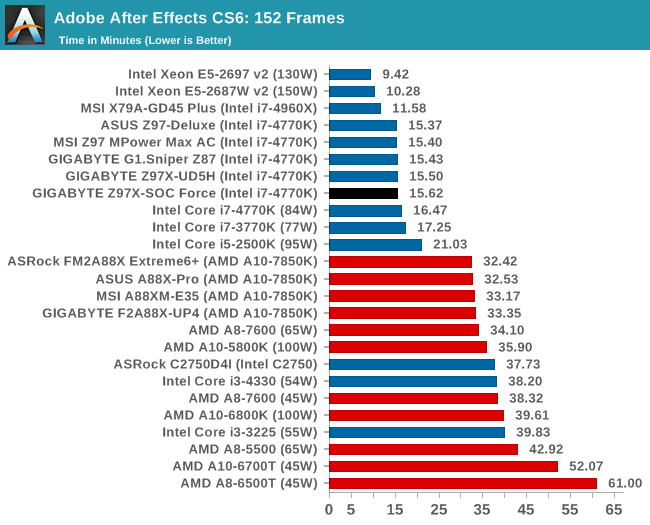
Compression – WinRAR 5.0.1: link
Our WinRAR test from 2013 is updated to the latest version of WinRAR at the start of 2014. We compress a set of 2867 files across 320 folders totaling 1.52 GB in size – 95% of these files are small typical website files, and the rest (90% of the size) are small 30 second 720p videos.
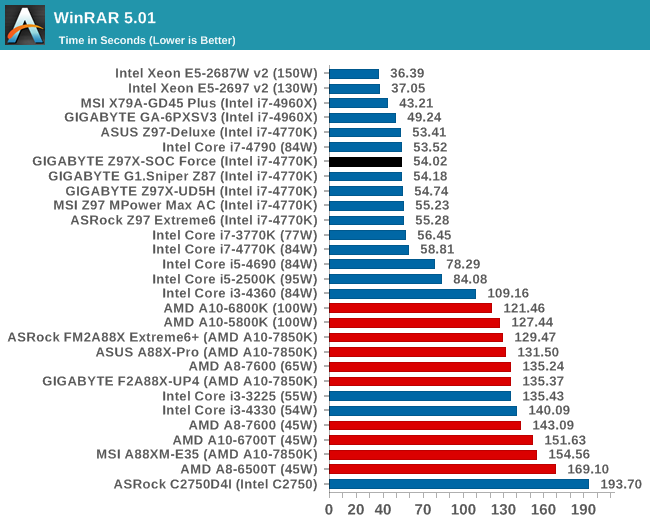
Image Manipulation – FastStone Image Viewer 4.9: link
Similarly to WinRAR, the FastStone test us updated for 2014 to the latest version. FastStone is the program I use to perform quick or bulk actions on images, such as resizing, adjusting for color and cropping. In our test we take a series of 170 images in various sizes and formats and convert them all into 640x480 .gif files, maintaining the aspect ratio. FastStone does not use multithreading for this test, and thus single threaded performance is often the winner.
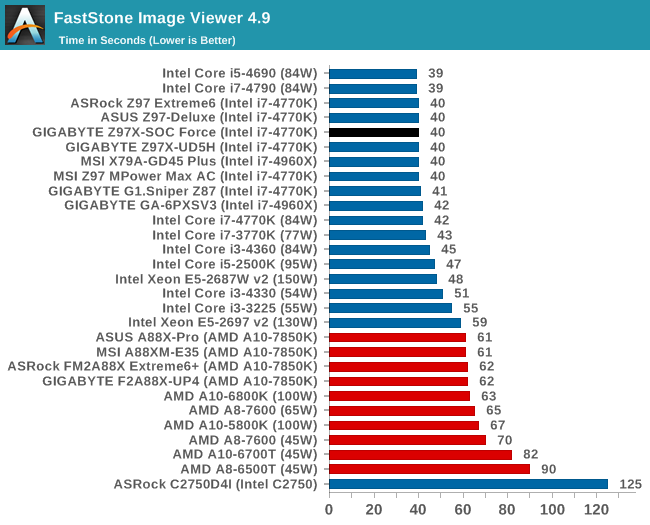
Video Conversion – Xilisoft Video Converter 7: link
The XVC test I normally do is updated to the full version of the software, and this time a different test as well. Here we take two different videos: a double UHD (3840x4320) clip of 10 minutes and a 640x266 DVD rip of a 2h20 film and convert both to iPod suitable formats. The reasoning here is simple – when frames are small enough to fit into memory, the algorithm has more chance to apply work between threads and process the video quicker. Results shown are in seconds and time taken to encode.

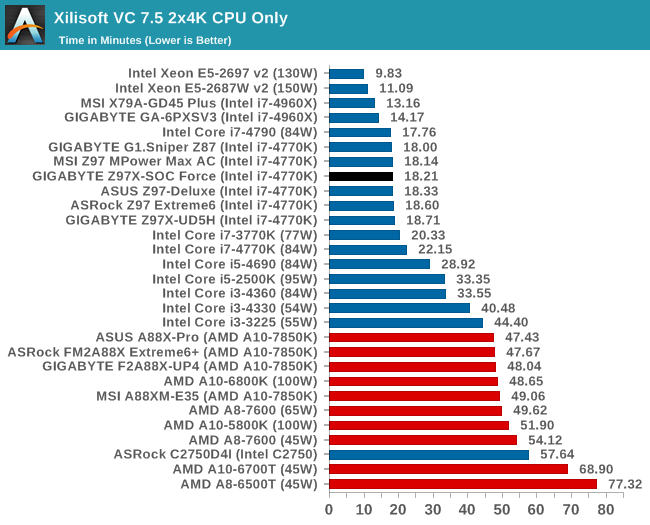
Video Conversion – Handbrake v0.9.9: link
Handbrake is a media conversion tool that was initially designed to help DVD ISOs and Video CDs into more common video formats. The principle today is still the same, primarily as an output for H.264 + AAC/MP3 audio within an MKV container. In our test we use the same videos as in the Xilisoft test, and results are given in frames per second.
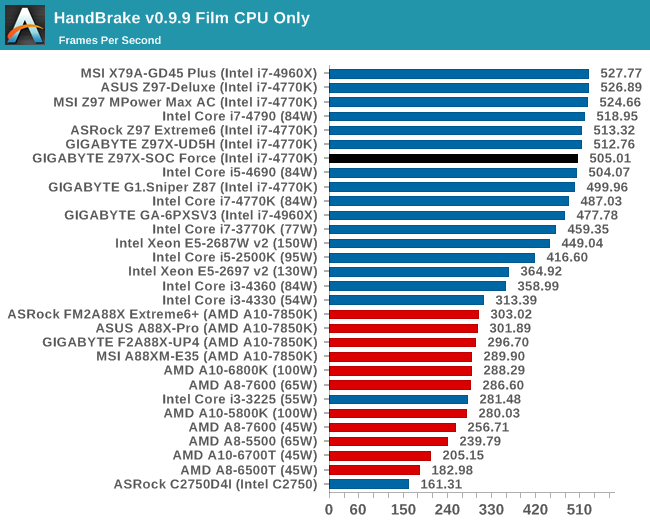
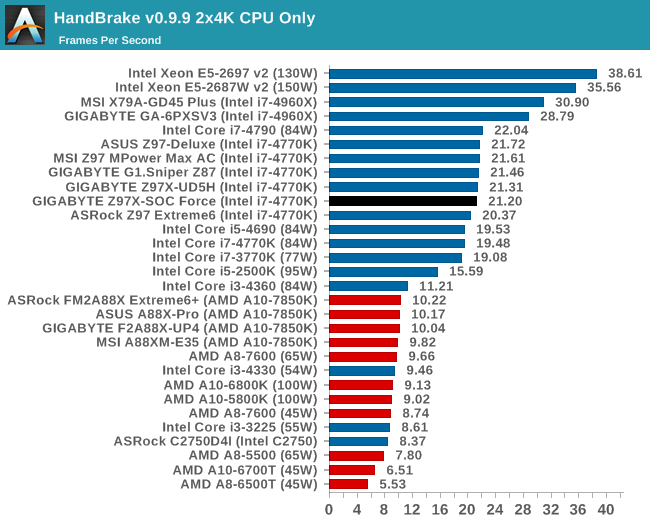
Rendering – PovRay 3.7: link
The Persistence of Vision RayTracer, or PovRay, is a freeware package for as the name suggests, ray tracing. It is a pure renderer, rather than modeling software, but the latest beta version contains a handy benchmark for stressing all processing threads on a platform. We have been using this test in motherboard reviews to test memory stability at various CPU speeds to good effect – if it passes the test, the IMC in the CPU is stable for a given CPU speed. As a CPU test, it runs for approximately 2-3 minutes on high end platforms.
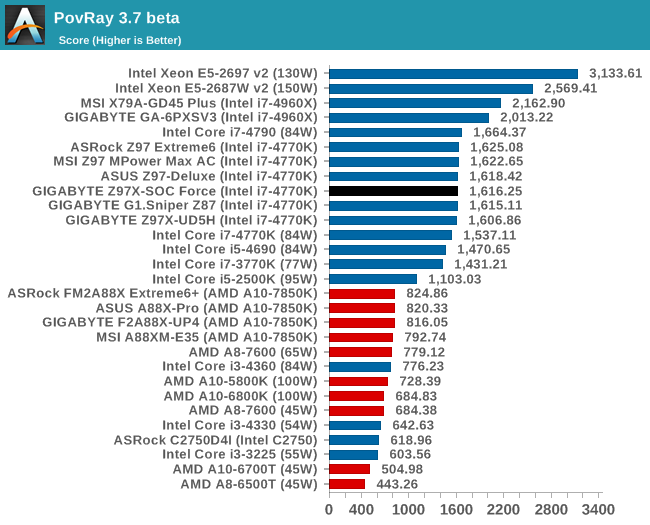










17 Comments
View All Comments
TiGr1982 - Friday, June 20, 2014 - link
This board should have been tested with new Devil's Canyon CPU.What's the point of using year-old 4770K?...
BTW, where is Devil's Canyon review? Sometimes Anandtech is severely lagging in real computing stuff review, hurrying to post a lot about iCrap and other smartphone toys...
haardrr - Sunday, June 22, 2014 - link
june 26 is the date the devils canyon review will appear. my guess based on the date that Newegg starts selling the Devils Canyon 4970 Khaardrr - Sunday, June 22, 2014 - link
um, err, make that a 4790k, not a 4970k...dragonhockey - Sunday, June 22, 2014 - link
If you are looking for a motherboard with an outstanding price, quality components, and a support team you can count on look no further than the motherboards from Gigabyte. It is well-known for years as they produce some of the toughest board and now giving you another state of the art motherboard loaded with new features.Joepublic2 - Monday, June 23, 2014 - link
Why don't you guys pry that heat sink off offer a more nuanced analysis of the board's VRM? There's so little to differentiate motherboards based on the same chipset these days; this is one of the few areas where they still differ significantly. It is good to see they're using screw fasteners on the heatsinks (like my z87 board) which I would expect have much higher mounting force/better heat transfer than the push pins used on some other gigabyte z97 boards.boe - Tuesday, June 24, 2014 - link
I'm hoping the GIGABYTE GA-Z97X-Gaming G1 starts to drop in price soon. Seems like a great design other than Intel's flaw in their lack of PCIe lanes for standard processors.OClock - Wednesday, April 8, 2015 - link
Could anyone tell me if this motherboard will work with i5 4690 and four NVIDIA GPUs ?My problem is that in a 4 GPU config, this motherboard runs at 8x 4x 4x 4x. Where as the CPU only supports max 16x express lanes. Now if the GPU is locked to 8x in first PCIe slot, then does that mean the i5 4690 will hit a bottle next after 3 GPUs? Considering that the first PCI slot will not run below 8x. Hence the 16x express lanes won't get divided into 4x 4x 4x 4x. Instead due to this, the motherboard it will run at 8x 4x 4x. I hope I didn't confuse anyone.
This rig I am building is for GPU rendering. And GPU rendering runs fine without SLI. No ATI either.